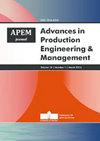人工神经网络、模糊逻辑和遗传算法在端面铣削过程中切削温度和表面粗糙度预测中的比较
IF 2.8
3区 工程技术
Q2 ENGINEERING, MANUFACTURING
引用次数: 27
摘要
作为最常见的加工操作之一,本文展示了将人工智能方法应用于铣削的可能性。研究的主要目标是根据铣削过程的输入参数:切削深度、切削速度和给齿量,获得铣削过程的选定输出特性的可靠智能模型。其中一个问题当然是确定加工过程的输入参数的值取决于目标函数,即铣削过程的输出特性。本文选取的目标函数是切削区的温度和加工表面的算术平均粗糙度。本文考察了通过人工神经网络、模糊逻辑和遗传算法获得的基于人工智能的三种模型的准确性。根据偏差的平均百分比误差,得出结论,三个模型中哪一个最充分地应用和实施在适当的过程系统中,这是基于人工智能的。©2020 CPE,马里博尔大学。版权所有。本文章由计算机程序翻译,如有差异,请以英文原文为准。
Comparison of artificial neural network, fuzzy logic and genetic algorithm for cutting temperature and surface roughness prediction during the face milling process
This paper shows the possibility of applying artificial intelligence methods in milling, as one of the most common machining operations. The main goal of the research is to obtain reliable intelligent models for selected output characteristics of the milling process, depending on the input parameters of the process: depth of cut, cutting speed and feed to the tooth. One of the problems is certainly determining the value of input parameters of the processing process depending on the objective function, i.e. the output characteristics of the milling process. The selected objective functions in this paper are the temperature in the cutting zone and arithmetic mean roughness of the machined surface. The paper examines the accuracy of three models based on artificial intelligence, obtained through artificial neural networks, fuzzy logic, and genetic algorithms. Based on the mean percentage error of deviation, conclusions were drawn as to which of the three models is most adequately applied and implemented in appropriate process systems, which are based on artificial intelligence. © 2020 CPE, University of Maribor. All rights reserved.
求助全文
通过发布文献求助,成功后即可免费获取论文全文。
去求助
来源期刊

Advances in Production Engineering & Management
ENGINEERING, MANUFACTURINGMATERIALS SCIENC-MATERIALS SCIENCE, MULTIDISCIPLINARY
CiteScore
5.90
自引率
22.20%
发文量
19
期刊介绍:
Advances in Production Engineering & Management (APEM journal) is an interdisciplinary international academic journal published quarterly. The main goal of the APEM journal is to present original, high quality, theoretical and application-oriented research developments in all areas of production engineering and production management to a broad audience of academics and practitioners. In order to bridge the gap between theory and practice, applications based on advanced theory and case studies are particularly welcome. For theoretical papers, their originality and research contributions are the main factors in the evaluation process. General approaches, formalisms, algorithms or techniques should be illustrated with significant applications that demonstrate their applicability to real-world problems. Please note the APEM journal is not intended especially for studying problems in the finance, economics, business, and bank sectors even though the methodology in the paper is quality/project management oriented. Therefore, the papers should include a substantial level of engineering issues in the field of manufacturing engineering.
 求助内容:
求助内容: 应助结果提醒方式:
应助结果提醒方式:


